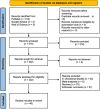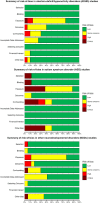Evaluation of the evidence on acetaminophen use and neurodevelopmental disorders using the Navigation Guide methodology
- PMID: 40804730
- PMCID: PMC12351903
- DOI: 10.1186/s12940-025-01208-0
Evaluation of the evidence on acetaminophen use and neurodevelopmental disorders using the Navigation Guide methodology
Abstract
Background: Acetaminophen is the most commonly used over-the-counter pain and fever medication taken during pregnancy, with > 50% of pregnant women using acetaminophen worldwide. Numerous well-designed studies have indicated that pregnant mothers exposed to acetaminophen have children diagnosed with neurodevelopmental disorders (NDDs), including autism spectrum disorder (ASD) and attention-deficit/hyperactivity disorder (ADHD), at higher rates than children of pregnant mothers who were not exposed to acetaminophen.
Methods: We applied the Navigation Guide methodology to the scientific literature to comprehensively and objectively examine the association between prenatal acetaminophen exposure and NDDs and related symptomology in offspring. We conducted a systematic PubMed search through February 25, 2025, using predefined inclusion criteria and rated studies based on risk of bias and strength of evidence. Due to substantial heterogeneity, we opted for a qualitative synthesis, consistent with the Navigation Guide's focus on environmental health evidence.
Results: We identified 46 studies for inclusion in our analysis. Of these, 27 studies reported positive associations (significant links to NDDs), 9 showed null associations (no significant link), and 4 indicated negative associations (protective effects). Higher-quality studies were more likely to show positive associations. Overall, the majority of the studies reported positive associations of prenatal acetaminophen use with ADHD, ASD, or NDDs in offspring, with risk-of-bias and strength-of-evidence ratings informing the overall synthesis.
Conclusions: Our analyses using the Navigation Guide thus support evidence consistent with an association between acetaminophen exposure during pregnancy and increased incidence of NDDs. Appropriate and immediate steps should be taken to advise pregnant women to limit acetaminophen consumption to protect their offspring's neurodevelopment.
Keywords: ADHD; ASD; Acetaminophen; Neurodevelopmental; Pregnancy.
© 2025. The Author(s).
Conflict of interest statement
Declarations. Human ethics and consent to participate: Not applicable. Competing interests: Dr. Baccarelli served as an expert witness for the plaintiff’s legal team on matters of general causation involving acetaminophen use during pregnancy and its potential links to neurodevelopmental disorders. This involvement may be perceived as a conflict of interest regarding the information presented in this paper on acetaminophen and neurodevelopmental outcomes. Dr. Baccarelli has made every effort to ensure that this current work—like his past work as an expert witness on this matter—was conducted with the highest standards of scientific integrity and objectivity.
Figures


References
-
- Han VX, Patel S, Jones HF, et al. Maternal immune activation and neuroinflammation in human neurodevelopmental disorders. Nat Rev Neurol. 2021;17(9):564–79. 10.1038/s41582-021-00530-8. - PubMed
-
- Rodrigues R, Lai MC, Beswick A, et al. Practitioner Review: Pharmacological treatment of attention-deficit/hyperactivity disorder symptoms in children and youth with autism spectrum disorder: a systematic review and meta-analysis. J Child Psychol Psychiatry. 2021;62(6):680–700. 10.1111/jcpp.13305. - PubMed
-
- Mitchell KJ. The genetics of neurodevelopmental disease. Curr Opin Neurobiol. 2011;21(1):197–203. 10.1016/j.conb.2010.08.009. - PubMed
-
- Piantadosi S, Byar DP, Green SB. The ecological fallacy. Am J Epidemiol. 1988;127(5):893–904. 10.1093/oxfordjournals.aje.a114892. - PubMed
Publication types
MeSH terms
Substances
Grants and funding
LinkOut - more resources
Full Text Sources
Medical

